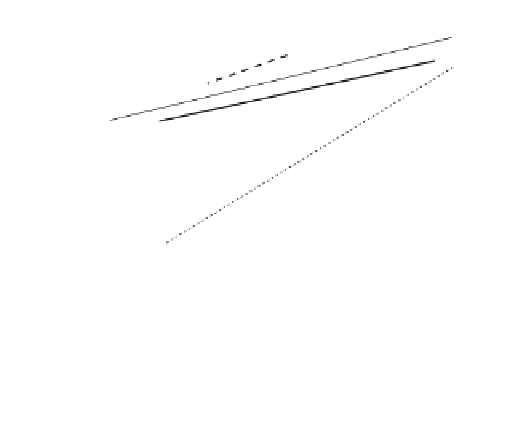Geoscience Reference
In-Depth Information
a tsunami earthquake occurred, with flow depths of over
15 m being recorded. The tsunami that struck the Sea of
Marmara, Turkey, on August 17, 1999 was unusual for two
reasons (Altinok et al.
1999
). First, it is a good example of a
tsunami that was not restricted to an ocean, but that occurred
in a small body of water. Second, it was caused by land
subsidence because the earthquake occurred on a strike-slip
rupture between the Eurasian and Turkish Plates—a feature
not conducive to tsunami. Finally, the Vanuatu event of
November 26, 1999 brought a slight glimmer of hope that we
were getting it correct (Caminade et al.
2000
). The tsunami
did not receive the publicity of the Flores or PNG events, but
on the island of Pentecost, it left a similar scene of
destruction. The death toll was only five. People had fled to
safety after they noticed a sudden drop in sea level. Though
there was little memory of any previous tsunami, they had
recently been shown an educational video based upon the
PNG event and had reacted accordingly. This section will
describe four of these events in Nicaragua, Flores, Japan, and
Papua New Guinea.
100
10
1
Chile
22 May 1960
Alaska
27 March 1964
0.1
0.01
7.0
8.0
9.0
10.0
Earthquake moment magnitude,
M
w
Fig. 5.4
Relationship between the moment magnitude, M
w
, and local
tsunami wave height for various coasts. a Results for the east coast of
Japan and Tahiti based on Okal (
1988
) and Kajiura (
1983
). Heights are
mean maximum run-ups. b Results for tsunami earthquakes and intra-
plate earthquakes based on Geist (
2012
). Heights are mean run-ups
The recent research reinforces the earlier work by Kajiura
(
1983
) for the Japanese coast. The only difference is that
Kajiura's work was for maximum tsunami run-up height
while Geist's (
2012
) research modeled mean run-up height.
Tsunami earthquakes, as expected, produce higher run-ups
for equivalent sized earthquakes. Tsunami earthquakes
appear to be limited to moment magnitudes, M
w
, below 8.3.
The results show that it should be possible to predict local
tsunami run-up heights for any Pacific Ocean earthquake
knowing its moment magnitude, M
w
. Unfortunately the time
between an earthquake and the arrival of its tsunami locally
may be very short.
5.4.1
Slow Nicaraguan Tsunami Earthquake
of September 2, 1992
The Nicaraguan Tsunami earthquake occurred at 7:16 PM
(00:16 UTC) on September 2, 1992, 70 km offshore from
Managua (Fig.
5.6
) (Satake et al.
1993
; Satake
1994
; Geist
1997
). It had a shallow focal depth of 45 km. Aftershocks
occurred along the strike, parallel to the coast of Nicaragua
in a band 100 km wide and 200 km long. The rupture
occurred as the result of slow thrusting along the shallow
dipping, subduction interface between the Cocos and
Caribbean Plates near a previously identified seismic gap.
The rupture propagated smoothly up-dip and alongshore at
a velocity of 1-5 km s
-1
over a period of 2 min (Fig.
5.1
).
For these reasons, the earthquake was barely felt by resi-
dents along the coast. The earthquake's moment magnitude,
M
w
, was 7.7, a value at least half an order of magnitude
greater than the surface wave magnitude, M
s
, of 7.2—a
disparity that characterizes tsunami earthquakes (Kanamori
and Kikuchi
1993
; Kikuchi and Kanamori
1995
). The tsu-
nami magnitude, M
t
, was 7.9-8.0, much higher than should
have been generated by an earthquake of this size.
The slow movement of the seabed generated a tsunami
that reached the coastline 40-70 min later (Abe et al.
1993
).
Healthy adults, who were awake at the time, were able to
outrun the tsunami. The tsunami killed 170 people, mostly
children who were asleep and infirmed people who could
not flee. Run-up averaged 4 m along 2 km of coastline
(Fig.
5.6
) and reached a maximum value of 10.7 m near El
Tránsito (Fig.
5.7
). This is about ten times higher than the
5.4
Events of the 1990s
In the last decade of the twentieth century, there have been
83 tsunami events—a number much higher than the average
historical rate of 57 per decade (Satake and Imamura
1995
;
Schindelé et al.
1995
; González
1999
). Similar to the
majority of past events, these tsunami have involved earth-
quakes and have been concentrated in the Pacific Ocean
region (Fig.
5.5
). The number of deaths during the 1990s has
totalled more than 4,000 (Table
5.4
). Many of the events
were unusual. For example, the October 9, 1995 Tsunami in
Mexico generated run-up heights of 1-5 m elevation.
However, in some places the rapidity of inundation was so
slow that people could outrun it at a trotting pace (Anon
2005
). A classic, slow tsunami earthquake caused the Nic-
araguan event of September 2, 1992 (Satake and Imamura
1995
). People at the shore hardly noticed the vibrations; yet,
within an hour a deadly wave was racing overtop them. One
of the most unusual tsunami was the Aitape, Papua New
Guinea Tsunami of July 17, 1998 (González
1999
). It formed












